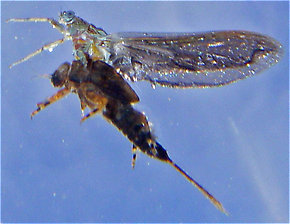Blog & Latest Updates
Fly Fishing Articles
Insects by Common Name


Caddisfly Genus Brachycentrus (Grannoms)
Taxonomic Navigation -?-
Kingdom
Animalia (Animals)
» Phylum
Arthropoda (Arthropods)
» Class
Insecta (Insects)
» Order
Trichoptera (Caddisflies)
» Genus Brachycentrus (Grannoms)
7 species aren't included.
Common Name
| Match | Common Name |
| Grannoms |
Note that this species changes color dramatically after it emerges, and imitations of egg-laying adults should be a different color from imitations of emergers. Emergers have pale blonde, almost off-white wings and bright green bodies, while the egg-laying adults have light brownish gray wings and medium green bodies.
Hatching Behavior
Most Brachycentrus species have very brief, very intense emergences on which trout feed steadily. Brachycentrus americanus is an exception, as its emergence may be more spread out.
The pupae are vulnerable to trout during their lengthy surface emergence.
Egg-Laying Behavior
Brachycentrus adult females land on and ride the water calmly to oviposit, so they are well-imitated with traditional tent-wing caddisfly patterns.
Larva & Pupa Biology
Diet: Algae, plankton
Shelter Type: Tapered wood cases of rectangular cross-section
Like many caddisflies, these larvae rappel between the rocks with a white silk anchor line. In Caddisflies, LaFontaine recommends imitating it by coloring the last eighteen inches of the leader white.Shelter Type: Tapered wood cases of rectangular cross-section
Special thanks to Lloyd Gonzales, author of the excellent new book Fly-Fishing Pressured Water, for helping to sort out the Brachycentrus species and common names.
Pictures of 7 Caddisfly Specimens in the Genus Brachycentrus:
Brachycentrus appalachia (Apple Caddis) Caddisfly Adult View 13 PicturesI captured this specimen in the same color as this photograph, during its egg-laying flight. The emergers are much lighter.
View 13 PicturesI captured this specimen in the same color as this photograph, during its egg-laying flight. The emergers are much lighter.
 View 13 PicturesI captured this specimen in the same color as this photograph, during its egg-laying flight. The emergers are much lighter.
View 13 PicturesI captured this specimen in the same color as this photograph, during its egg-laying flight. The emergers are much lighter.Collected May 13, 2007 from the West Branch of the Delaware River in New York
Added to Troutnut.com by Troutnut on May 18, 2007
Added to Troutnut.com by Troutnut on May 18, 2007
Brachycentrus appalachia (Apple Caddis) Caddisfly Adult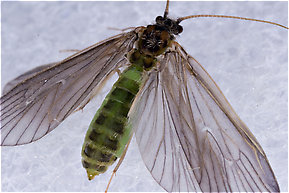 View 9 PicturesThe wings of this specimen were pale tan, almost white, when I collected it, and the body was of the lighter "apple green" from which this species gets its common name. Everything turned much darker by the time I got it home and under the camera.
View 9 PicturesThe wings of this specimen were pale tan, almost white, when I collected it, and the body was of the lighter "apple green" from which this species gets its common name. Everything turned much darker by the time I got it home and under the camera.
The wings look even darker in some of these pictures because the background is black and the wings are unusually translucent. You can see that in one of the pictures where the body easily through the wings. They're really a light, translucent gray, which is still far from the pale tan of the same fly when it was freshly emerged.
 View 9 PicturesThe wings of this specimen were pale tan, almost white, when I collected it, and the body was of the lighter "apple green" from which this species gets its common name. Everything turned much darker by the time I got it home and under the camera.
View 9 PicturesThe wings of this specimen were pale tan, almost white, when I collected it, and the body was of the lighter "apple green" from which this species gets its common name. Everything turned much darker by the time I got it home and under the camera.The wings look even darker in some of these pictures because the background is black and the wings are unusually translucent. You can see that in one of the pictures where the body easily through the wings. They're really a light, translucent gray, which is still far from the pale tan of the same fly when it was freshly emerged.
Collected May 15, 2007 from the West Branch of the Delaware River in New York
Added to Troutnut.com by Troutnut on May 18, 2007
Added to Troutnut.com by Troutnut on May 18, 2007
Brachycentrus (Grannoms) Caddisfly Pupa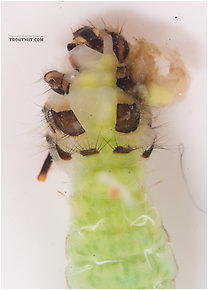 View 10 PicturesThe green blob contained in this case is a pupa in the early stages of transformation from larva to the final stage we generally picture and imitate. This specimen and several like it were fixed to a rock I picked up, and each one had the front of its case sealed off, protecting the helpless pupa from predation. It's neat to see the insect part-way through such a radical transformation.
View 10 PicturesThe green blob contained in this case is a pupa in the early stages of transformation from larva to the final stage we generally picture and imitate. This specimen and several like it were fixed to a rock I picked up, and each one had the front of its case sealed off, protecting the helpless pupa from predation. It's neat to see the insect part-way through such a radical transformation.
It was very hard to extract this thing from its case, so there's a bit of extra goo near the head from where I accidentally punctured it.
 View 10 PicturesThe green blob contained in this case is a pupa in the early stages of transformation from larva to the final stage we generally picture and imitate. This specimen and several like it were fixed to a rock I picked up, and each one had the front of its case sealed off, protecting the helpless pupa from predation. It's neat to see the insect part-way through such a radical transformation.
View 10 PicturesThe green blob contained in this case is a pupa in the early stages of transformation from larva to the final stage we generally picture and imitate. This specimen and several like it were fixed to a rock I picked up, and each one had the front of its case sealed off, protecting the helpless pupa from predation. It's neat to see the insect part-way through such a radical transformation.It was very hard to extract this thing from its case, so there's a bit of extra goo near the head from where I accidentally punctured it.
Collected April 14, 2007 from Cayuta Creek in New York
Added to Troutnut.com by Troutnut on April 22, 2007
Added to Troutnut.com by Troutnut on April 22, 2007
3 Underwater Pictures of Brachycentrus Caddisflies:
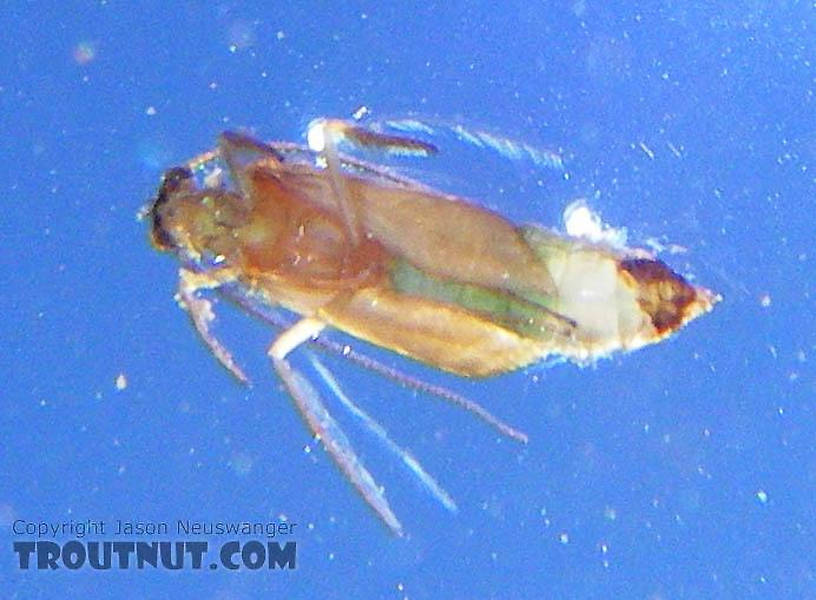
A Brachycentrus "Apple Caddis" pupa scoots around in the surface film. Apparently it had some difficulty emerging, so I was able to slip my camera underneath it and take a picture from below.
In this picture: Caddisfly Species Brachycentrus appalachia (Apple Caddis).
In this picture: Caddisfly Species Brachycentrus appalachia (Apple Caddis).
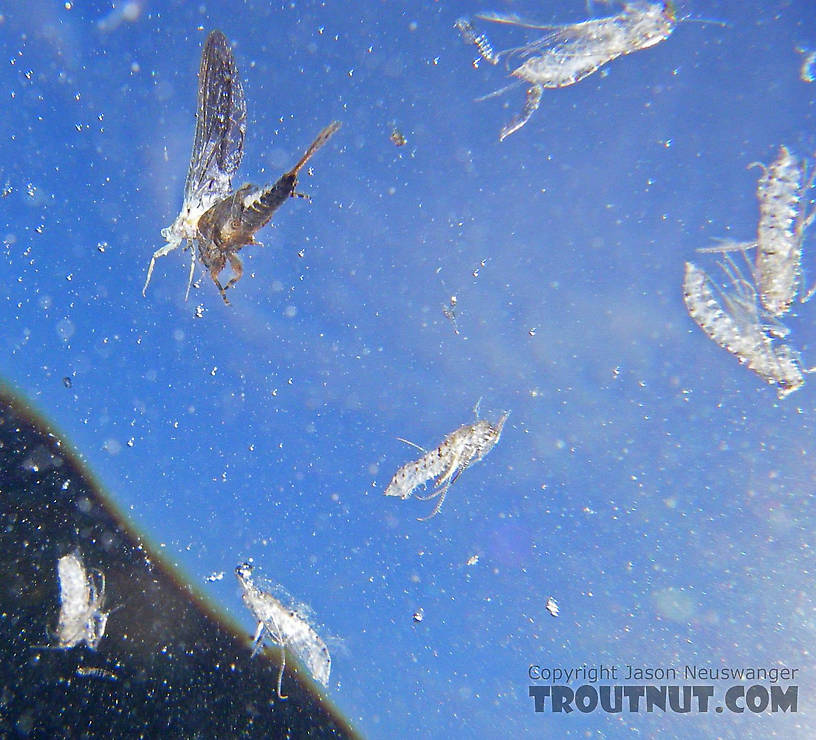
This picture from below shows a stillborn (Stillborn: In fly fishing, a stillborn insect is one which got stuck in its nymphal or pupal shuck during emergence and floats helplessly on the surface instead of flying away. It is a specific class of cripple, although it is sometimes used interchangeably with that term.) Ephemerella subvaria (Hendrickson) dun drifting on the surface amidst a number of shed pupal skins from Brachycentrus caddisflies which were heavily hatching that day.
In this picture: Caddisfly Species Brachycentrus appalachia (Apple Caddis) and Mayfly Species Ephemerella subvaria (Hendrickson).
In this picture: Caddisfly Species Brachycentrus appalachia (Apple Caddis) and Mayfly Species Ephemerella subvaria (Hendrickson).
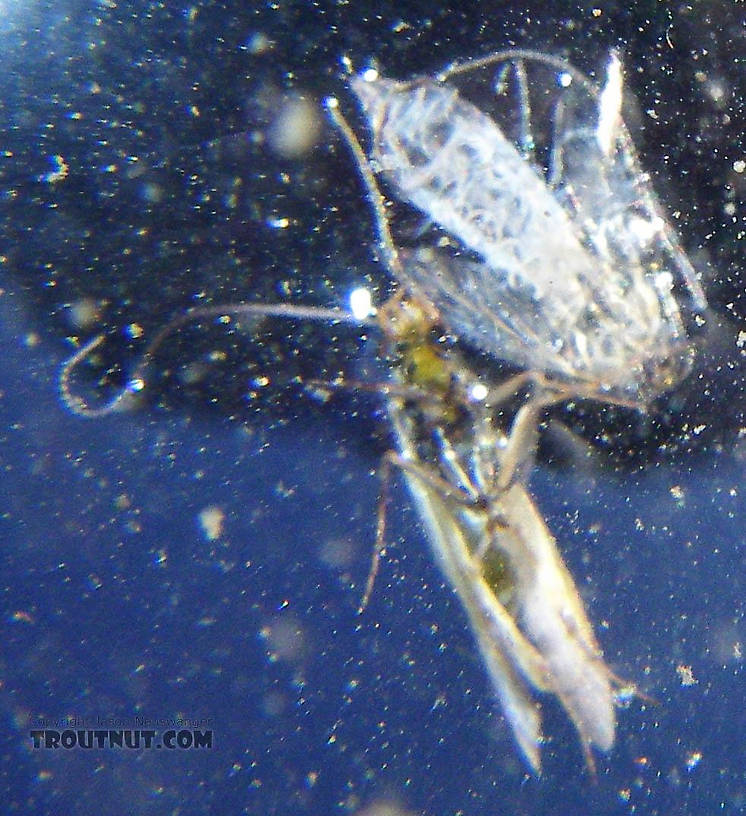
This Brachycentrus "Apple Caddis" struggled more than its kin in escaping its pupal skin, enabling me to take an underwater picture of it from directly below. This is sort of a trout's eye view, but I used the flash for the picture so the transparent shuck (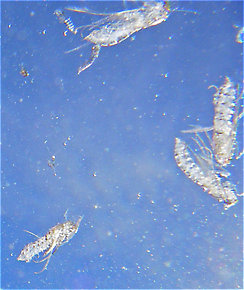 Shuck: The shed exoskeleton left over when an insect molts into its next stage or instar. Most often it describes the last nymphal or pupal skin exited during emergence into a winged adult.) appears far brighter than it really is.
Shuck: The shed exoskeleton left over when an insect molts into its next stage or instar. Most often it describes the last nymphal or pupal skin exited during emergence into a winged adult.) appears far brighter than it really is.
In this picture: Caddisfly Species Brachycentrus appalachia (Apple Caddis).

Here's an underwater view of the pupal shucks of several already-emerged Brachycentrus numerosus caddisflies.
In this picture: Caddisfly Species Brachycentrus appalachia (Apple Caddis).
Recent Discussions of Brachycentrus
Brachycentrus americanus on the Lower Sacramento River California
Posted by Troutguide on Oct 29, 2016 in the species Brachycentrus americanus
I believe this is the species found in sometimes very large numbers on the Lower Sacramento River in the Redding area. Ten years ago it was present in such large numbers that fishing a fly on the bottom resulted in frequently hooking one of these caddis still in its case. Along with other aquatic insects their numbers have declined to a fraction of once seen. I don't believe the egg Sac dropped by the females to be olive , instread I have seen it to be a bright green. The females seem to oviposit close to the edge of flowing water and not midstream.
Replygrannom caddis 56 Replies »Hi All! I was reading through the site and I happened upon the Grannom (Apple) Caddis page, which made me wonder. Here in PA it is called The Mother's Day Caddis, I believe. Adults, which trout rarely feed on, are imitated with black or peacock herl bodies. The pupa, or emrgers I guess, we imitate with a wet fly. It has a peacock herl body and brown hackle for the legs, etc. in a size 14. Is this the same Grannon as the apple Grannom? Just curious!
I still get confused by these caddis and I'm trying to narrow down a list of caddis patterns and colors to cover the largest percentage of the hatches throughout the year.
ReplyWhat's happening here? 5 Replies »I still get confused by these caddis and I'm trying to narrow down a list of caddis patterns and colors to cover the largest percentage of the hatches throughout the year.
Check out the two streamside pictures on my Brachycentrus page. I found these clusters of dead grannoms in a few different spots along a Catskill river on May 12th, while many members of (seemingly) the same species were in the air laying eggs and occasionally falling spent and being eaten by trout.
Have you ever seen these clusters? What's the explanation?
ReplyHave you ever seen these clusters? What's the explanation?
There are 676 more topics.
Your Thoughts On Brachycentrus:
Top 10 Fly Hatches
Top Gift Shop Designs
Eat mayflies.
Top Insect Specimens
Miscellaneous Sites
Troutnut.com is copyright © 2004-2024 Jason
Neuswanger (email Jason). See my FAQ for information about use of my images.
 privacy policy
privacy policy

